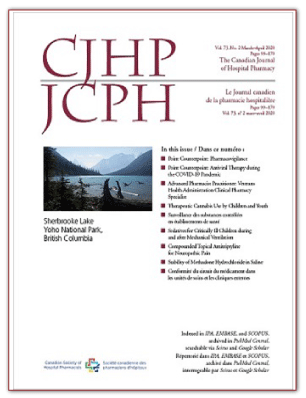Surveillance des substances contrôlées en établissements de santé : une contribution à la gestion de la crise des opioïdes au Canada
DOI:
https://doi.org/10.4212/cjhp.v73i2.2977Keywords:
consommation, substances contrôlées, substances désignées, opioïdes, dose définie journalière, gouvernance des substances contrôlées, consumption, controlled substances, designated substances, opioids, defined daily dose, controlled substances stewardshipAbstract
RÉSUMÉ
Contexte : La consommation des substances contrôlées et plus particulièrement des opioïdes est un enjeu de santé publique. Le Canada se situe au deuxième rang des plus gros consommateurs d’opioïdes dans le monde. L’utilisation de ces substances est associée à des problèmes de mésusage. À preuve, une crise des opioïdes sévit en Amérique du Nord.
Objectifs : Décrire et analyser les tendances de consommation des substances contrôlées au sein d’un établissement de santé de 2003-2004 à 2017-2018. Proposer un outil de surveillance de la consommation des substances contrôlées dans un établissement de santé.
Methodologie : Étude descriptive rétrospective. À partir du logiciel de gestion des approvisionnements, nous avons extrait les données de consommation de toutes les substances contrôlées du 1er avril 2003 au 31 mars 2018. Les données ont été exprimées selon l’index de la classification Anatomical Therapeutic Chemical en nombre de doses
définies journalières (DDJ) pour 1000 jours-présence avec les valeurs de DDJ proposées par l’Organisation mondiale de la santé. Seules des statistiques descriptives ont été effectuées.
Resultats : Durant les 15 dernières années, la consommation des substances contrôlées a diminué de 43 % au sein de notre établissement (min. : 739; max. : 1292 DDJ/1000 jours-présence par année). De 2003- 2004 à 2017-2018, les principales classes thérapeutiques consommées par ordre décroissant étaient : opioïdes, hypnotiques et sédatifs, anxiolytiques et anesthésiques généraux. Les principales molécules opioïdes consommées en 2017-2018 sont l’hydromorphone et la morphine injectable.
Conclusions : Cette étude descriptive rétrospective montre une diminution de la consommation des substances contrôlées au sein de notre établissement de 2003-2004 à 2017-2018. Elle démontre la faisabilité de développer un outil de surveillance de la consommation des substances contrôlées en établissement de santé. Une telle approche pourrait être implantée à large échelle afin de favoriser les comparaisons entre les établissements.
ABSTRACT
Background: The use of controlled substances, especially opioids, is a public health concern. Canada is the country with the second greatest opioid use in the world. The use of these substances is associated with problems of misuse, as evidenced by North America’s opioid crisis.
Objectives: To describe and analyze usage patterns for controlled substances in a health care facility from 2003/04 to 2017/18, and to propose a tool for monitoring the use of controlled substances in this setting.
Method: In this retrospective descriptive study, usage data for all controlled substances were extracted from the institution’s supply management software for the period April 1, 2003, to March 31, 2018. The data are presented according to the Anatomical Therapeutic Chemical classification in terms of number of Defined Daily Doses
(DDD) per 1000 inpatient-days, using the DDD values proposed by the World Health Organization. Only descriptive statistics were determined.
Results:During the last 15 years, use of controlled substances at the study facility dropped by 43% (min. 739 and max. 1292 DDD/1000 inpatient-days per year). From 2003/04 to 2017/18, the main therapeutic classes consumed (in decreasing order) were opioids, hypnotics and sedatives, anxiolytics, and general anesthetics. The main opioid molecules consumed in 2017/18 were hydromorphone and injectable morphine.
Conclusions: This retrospective descriptive study showed a decrease in the consumption of controlled substances in the study facility from 2003/04 to 2017/18. It also demonstrated the feasibility of developing a tool for monitoring the use of controlled substances in a health care facility. This approach could be implemented at a larger scale to foster comparisons between facilities.
Downloads
Published
Issue
Section
License
Copyright © Canadian Society of Healthcare-Systems Pharmacy.
After publication of a manuscript in the CJHP, the authors of the manuscript must obtain written permission from the CSHP (publications@cshp.ca) before reproducing any text, figures, tables, or illustrations from the work in future works of their own. If a submitted manuscript is declined for publication in the CJHP, all said rights shall revert to the authors. Please note that any forms (e.g., preprinted orders and patient intake forms) used by a specific hospital or other health care facility and included as illustrative material with a manuscript are exempt from this copyright transfer. The CJHP will require a letter from the hospital or health care facility granting permission to publish the document(s).










